

EMI Cassette Tapes
Gold Top Inlay Series
#16. Yellow Submarine (TC-PCS 7070)
(Update: 25th. May 2024)




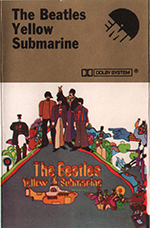 |
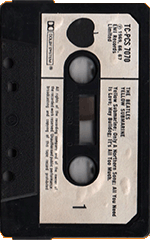 |
|
|
| Gold Inlay and
Tape |
|||
|
TITLE
|
YELLOW SUBMARINE |
|||
| CATALOG NUMBER | TC-PCS 7070 / 0C 244 o 04002 |
|||
|
RELEASE DATE
|
August 1974 / First Issue? | |||
| TRACK LISTING | SIDE 1 | SIDE 2 | ||
| THE BEATLES |
THE BEATLES | |||
| Yellow Submarine [A1] |
All Together Now [A3] |
|||
| Only A Northern Song [A2] |
ORIGINAL FILM SCORE |
|||
| All You Need Is Love [A6] |
Pepperland [B1] |
|||
| Hey Bulldog [A4] |
Sea Of Time [B2] |
|||
| It's All Too Much [A5] | Sea Of Holes [B3] |
|||
| |
Sea Of Monsters [B4] |
|||
| |
March Of The Meanies [B5] |
|||
| |
Pepperland Laid Waste [B6] |
|||
| |
Yellow Submarine In Pepperland [B7] | |||
| CASSETTE CASE AND TAPE |
CASE FRONT | CASE BACK | SIDE 1 --> Click! | SIDE 2 --> Click! |
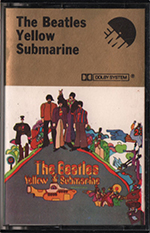 |
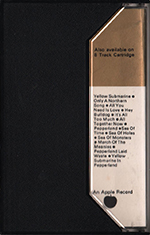 |
 |
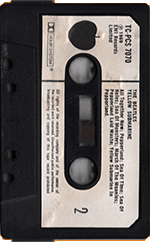 |
|
| The cassette cases ("Norelco" cases)
were clear plastic at the front and around the spine area,
and black plastic at the rear. |
The first UK issue has White paper label with Apple
logo |
|||
| INLAY |
INLAY: FRONT | INLAY: INSIDE |
||
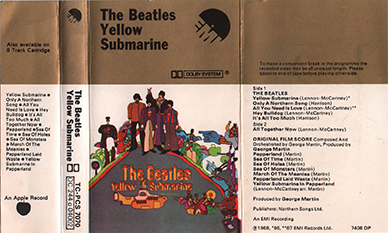 |
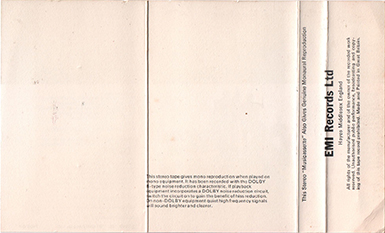 |
|||
| EMI "Gold Top" cassette inlay, with
"Circular" EMI logo (introduced by EMI from mid-1973). ”Gold Top inlay" are believed to have been introduced in January 1972. |
||||
| INLAY: FRONT CLOSE UP | ||||
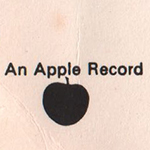 |
The words
"An Apple Record" and black apple logomark were printed on
the inlay. |
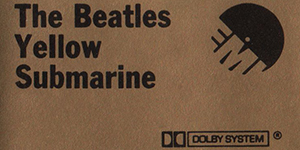 |
EMI "Gold Top" cassette
inlay, with "Circular" EMI logo (introduced by EMI from
mid-1973). "DOLBY" logo was printed. |
|
 |
 |
|||
| INLAY: FRONT CLOSE UP | ||||
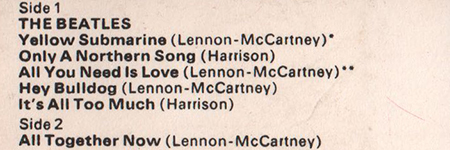 |
EMI
originally issued the Beatles UK albums on cassette tape
with re-arranged running orders, the excuse being the need
to have two sides of equal length to avoid the problem of
listeners stopping the tape at the end of one side and
turning over to start mid-way through the opening track on
the reverse. |
|||
| INLAY: INSIDE CLOSE UP | ||||
 |
Catalog number "TC-PCS 7070" and the EMI country code (*1) were printed on the inlay. |  |
Printer company's name and relrease date "7408 DP(**)" was printed at the bottom of the inlay. | |
| INLAY: INSIDE CLOSE UP | ||||
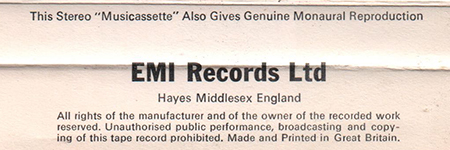 |
"EMI Records
Ltd Hayes Middlesex England" credit and "Made and
Printed in Great Britain" were printed at the bottom of the
inside of the inlay. |
|||
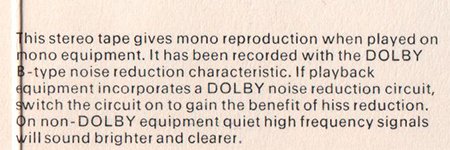 |
The phrase "It has been
recorded with the DOLBY B-type noise reduction
characteristic" was printed on the inlay. |
|||
| LABEL CLOSE UP | ||||
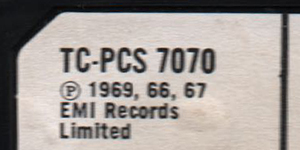 |
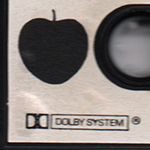 |
"TC-PCS 7070" catalogue
number and Apple logo were printed. The "DP(**)" logo can be found moulded into cassette shells, especially during the early to mid 1970s. |
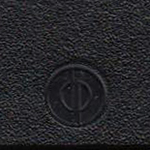 |
|
| LABEL CLOSE UP | ||||
| SIDE
1 |
SIDE 2 |
EMI originally issued the Beatles UK albums on cassette tape with re-arranged running orders. | ||
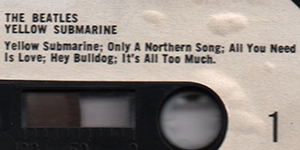 |
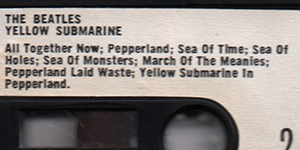 |
|||
| LABEL CLOSE UP | ||||
 |
"Made
in U.S.A" was embossed on the shell. |
|||
| OTHER ITEM | ||||
| - |
||||
| LABEL | White Paper Label with Apple logo / Black
shell |
|||
| MIX | STEREO / DOLBY B-type |
|||
| RECORD COMPANY'S NAME | EMI Records Ltd / An Apple Record |
|||
| CENTRAL REMARK "SOLD IN U.K." |
- | |||
| RECORDING PUBLISHED CREDIT | (P) 1969, 66,67 |
|||
| INLAY FORM | Metallic effect gold inlay (Foldover) |
|||
| SHELL | Black Shell / embossed "MADE IN
USA" and "dp" logo mark |
|||
| CASSETTE CASE |
"Norelco"
cases: clear plastic at the front and around the spine area,
and black plastic at the rear. |
|||
| PRINTER CREDIT | Made and Printed in Great Britain / 7408
DP |
|||
| COVER DESIGN/ PHOTO/ NOTES | Art Design: Heinz Edelmann |
|||
| PRODUCER | George Martin | |||
| COMMENTS | White paper label with Apple
logo cassette, with black shell. EMI "Gold Top" cassette inlay, with "Circular" EMI logo (introduced by EMI from mid-1973). ”Gold Top inlay" are believed to have been introduced in January 1972. Note the 7XXX notation on the inside inlay followed by either EJD, G&L or DP. This was the number of the year/month of issue, followed by the printers initials ( Ernest J Day, Garrod & Lofthouse or Data Packaging). Cassette originally released in 1974 (see the "7408 DP(**)" note on the inlay's inner flap - "74" for the year, "08" for August). This version with black cassette with DP(**) logo moulding. It has a tape shell that is very faintly stamped "Made In U.S.A." on Side One (almost imperceptible). The EMI UK catalogue no. (TC-PCS-XXXX) was on the spine. The cassette cases ("Norelco" cases) were clear plastic at the front and around the spine area, and black plastic at the rear. The "DP(**)" logo can often be found moulded into cassette shells, especially during the early to mid 1970s EMI originally issued the Beatles UK albums on cassette tape with re-arranged running orders, the excuse being the need to have two sides of equal length to avoid the problem of listeners stopping the tape at the end of one side and turning over to start mid-way through the opening track on the reverse. These were the first Beatles cassettes to be manufactured by EMI themselves at their newly-opened (July, 1970) tape duplicating facilities at Hayes in Middlesex. Previously, the Dutch electronics giant, Phillips, had made them for EMI. All came with bright yellow paper label cassettes, their I international catalogue numbers, and the newly designed, black box, EMI/Parlophone logo - although some were issued without the logo due to a lack of expensive letterpress blocks. (*1) EMI country code: 0C 244 o 04002 The EMI country codes (introduced on 1 June, 1969): In most cases the EMI Codes are the first two letters of the record's catalog#. These EMI Country Codes were used to indicate the country in which the record was pressed. Note this doesn't necessarily means the record was also released in that country (from Discog). OC / 0C / 1E= UK (**)Data Packaging Corporation: (who also traded as Hellerman Data Packaging Ltd) supplied cassette and 8 track shells, tape and other components to the music industry. The "DP" logo can often be found moulded into cassette shells, especially during the early to mid 1970s. DOLBY B-type: A Dolby noise-reduction system, or Dolby NR, is one of a series of noise reduction systems developed by Dolby Laboratories for use in analog audio tape recording. The first was Dolby A, a professional broadband noise reduction system for recording studios in 1965, but the best-known is Dolby B (introduced in 1968) for the consumer market, which helped make high fidelity practical on cassette tapes, which used a relatively noisy tape size and speed. From the mid-1970s, Dolby B became standard on commercially pre-recorded music cassettes. |
|||
|
TITLE
|
YELLOW SUBMARINE |
|||
| CATALOG NUMBER | TC-PCS 7070 / 0C 244 o 04002 |
|||
|
RELEASE DATE
|
1976? / Second Issue? | |||
| TRACK LISTING | SIDE 1 | SIDE 2 | ||
| THE BEATLES |
THE BEATLES | |||
| Yellow Submarine [A1] |
All Together Now [A3] |
|||
| Only A Northern Song [A2] |
ORIGINAL FILM SCORE |
|||
| All You Need Is Love [A6] |
Pepperland [B1] |
|||
| Hey Bulldog [A4] |
Sea Of Time [B2] |
|||
| It's All Too Much [A5] | Sea Of Holes [B3] |
|||
| |
Sea Of Monsters [B4] |
|||
| |
March Of The Meanies [B5] |
|||
| |
Pepperland Laid Waste [B6] |
|||
| |
Yellow Submarine In Pepperland [B7] | |||
| CASSETTE CASE AND TAPE |
CASE FRONT | CASE BACK | SIDE 1 --> Click! | SIDE 2 --> Click! |
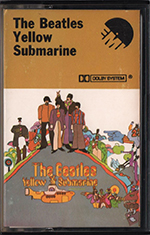 |
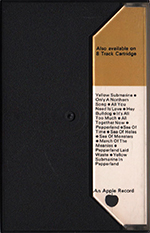 |
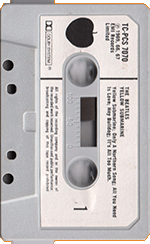 |
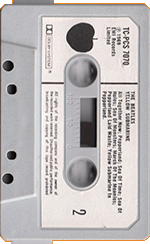 |
|
| The cassette cases ("Norelco" cases)
were clear plastic at the front and around the spine area,
and black plastic at the rear. |
The UK issue has White paper label with Apple
logo on light grey shell |
|||
| INLAY |
INLAY: FRONT | INLAY: INSIDE |
||
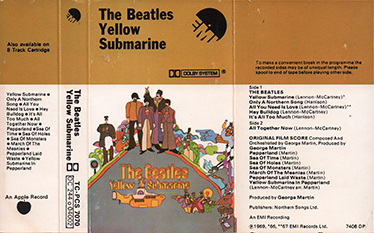 |
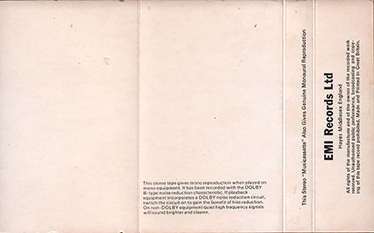 |
|||
| Changed the"Ochre" cassette inlay.
Does not have 'metallic' gold finish. ”Ochre inlay" have been introduced in 1976 (maybe). |
||||
| INLAY: FRONT CLOSE UP | ||||
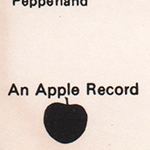 |
The words
"An Apple Record" and black apple logomark were printed on
the inlay. |
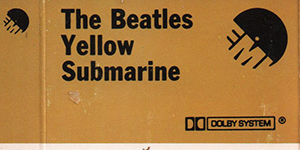 |
EMI Ochre cassette
inlay with "Circular" EMI logo (introduced by EMI from
mid-1973). "DOLBY" logo was printed. |
|
 |
 |
|||
| INLAY: FRONT CLOSE UP | ||||
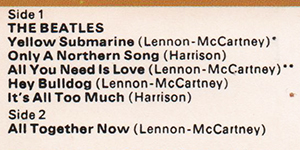 |
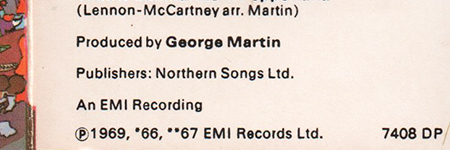 |
|||
| EMI originally issued the Beatles
UK albums on cassette tape with re-arranged running orders,
the excuse being the need to have two sides of equal length
to avoid the problem of listeners stopping the tape at the
end of one side and turning over to start mid-way through
the opening track on the reverse. |
||||
| INLAY: INSIDE CLOSE UP | ||||
 |
Catalog number "TC-PCS 7070" and the EMI country code (*1) were printed on the inlay. |  |
Printer company's name and relrease date "7408 DP(**)" was printed at the bottom of the inlay. | |
| INLAY: INSIDE CLOSE UP | ||||
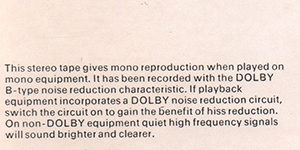 |
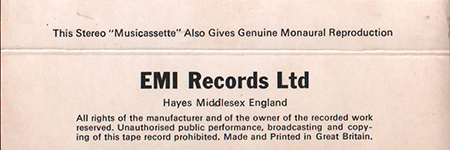 |
|||
| The phrase "It has been recorded with the DOLBY B-type noise reduction characteristic" was printed on the inlay. | "EMI Records Ltd Hayes Middlesex England" credit and "Made and Printed in Great Britain" were printed at the bottom of the inside of the inlay. | |||
| LABEL CLOSE UP | ||||
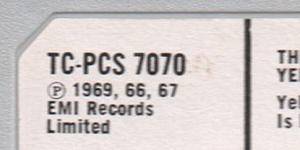 |
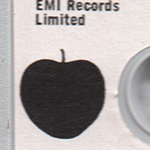 |
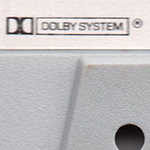 |
 |
|
| "IE" catalogue
number (*) in addition to the ordinary "TC-PCS 7096" EMI
catalogue number, but not printed on the label. |
The cassettes was issued Apple
logo in black ink. |
"Dolby System" logo was added on the label. | NO mark was moulded
into cassette shells. |
|
| LABEL CLOSE UP | ||||
| SIDE
1 |
SIDE 2 |
EMI originally issued the Beatles UK albums on cassette tape with re-arranged running orders. | ||
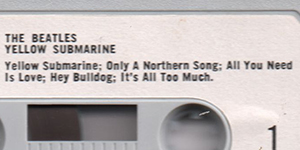 |
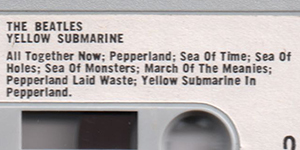 |
|||
| LABEL CLOSE UP | ||||
 |
"Made
in
U.S.A / Made in England" was not embossed on the
shell. |
|||
| OTHER ITEM | ||||
| - |
||||
| LABEL | White Paper Label with Apple logo / Light
Grey shell |
|||
| MIX | STEREO / DOLBY B-type |
|||
| RECORD COMPANY'S NAME | EMI Records Ltd / An Apple Record |
|||
| CENTRAL REMARK "SOLD IN U.K." |
- | |||
| RECORDING PUBLISHED CREDIT | (P) 1969, 66,67 |
|||
| INLAY FORM | "Ochre" inlay (Foldover) |
|||
| SHELL | Light Grey Shell |
|||
| CASSETTE CASE |
"Norelco"
cases:
clear plastic at the front and around the spine area, and
black plastic at the rear. |
|||
| PRINTER CREDIT | Made and Printed in Great Britain / 7408
DP |
|||
| COVER DESIGN/ PHOTO/ NOTES | Art Design: Heinz Edelmann |
|||
| PRODUCER | George Martin | |||
| COMMENTS | White paper label with Apple
logo cassette, with light grey shell. “Gold Top inlay” are believed to have been introduced in January 1972. Changed the "Ochre" cassette inlay. Does not have 'metallic' gold finish. ”Ochre inlay" have been introduced in 1976 (maybe). Note the 7XXX notation on the inside inlay followed by either EJD, G&L or DP. This was the number of the year/month of issue, followed by the printers initials ( Ernest J Day, Garrod & Lofthouse or Data Packaging). Cassette originally released in 1974 (see the "7408 DP(**)" note on the inlay's inner flap - "74" for the year, "08" for August). The EMI UK catalogue no. (TC-PCS-XXXX) was on the spine. The cassette cases ("Norelco" cases) were clear plastic at the front and around the spine area, and black plastic at the rear. EMI originally issued the Beatles UK albums on cassette tape with re-arranged running orders, the excuse being the need to have two sides of equal length to avoid the problem of listeners stopping the tape at the end of one side and turning over to start mid-way through the opening track on the reverse. These were the first Beatles cassettes to be manufactured by EMI themselves at their newly-opened (July, 1970) tape duplicating facilities at Hayes in Middlesex. Previously, the Dutch electronics giant, Phillips, had made them for EMI. All came with bright yellow paper label cassettes, their I international catalogue numbers, and the newly designed, black box, EMI/Parlophone logo - although some were issued without the logo due to a lack of expensive letterpress blocks. (*1) EMI country code: 0C 244 o 04002 The EMI country codes (introduced on 1 June, 1969): In most cases the EMI Codes are the first two letters of the record's catalog#. These EMI Country Codes were used to indicate the country in which the record was pressed. Note this doesn't necessarily means the record was also released in that country (from Discog). OC / 0C / 1E= UK (**)Data Packaging Corporation: (who also traded as Hellerman Data Packaging Ltd) supplied cassette and 8 track shells, tape and other components to the music industry. The "DP" logo can often be found moulded into cassette shells, especially during the early to mid 1970s. DOLBY B-type: A Dolby noise-reduction system, or Dolby NR, is one of a series of noise reduction systems developed by Dolby Laboratories for use in analog audio tape recording. The first was Dolby A, a professional broadband noise reduction system for recording studios in 1965, but the best-known is Dolby B (introduced in 1968) for the consumer market, which helped make high fidelity practical on cassette tapes, which used a relatively noisy tape size and speed. From the mid-1970s, Dolby B became standard on commercially pre-recorded music cassettes. |
|||